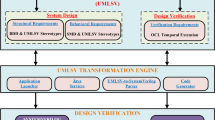Abstract
Development of AUTOSAR-based systems using UML tools is gaining significant attention in the automotive industry. In this context, incorporating an early and automated model-based timing analysis of such systems in state-of-the-practice timing analysis tools is a significant step towards automated tooling for Verification & Validation (V&V) in the AUTOSAR-based development process; nevertheless is missing. Addressing this aspect, a workflow for early model-based timing analysis of AUTOSAR models is outlined. A detailed discussion of the model transformations for extracting a timing analysis model from a timing annotated AUTOSAR-based design model is presented in this book chapter. Further, a detailed case study of an automotive use case is presented and evaluated step-by-step by employing the outlined workflow. An early model-based timing analysis of the use case developed in UML is discussed in detail.
Access this chapter
Tax calculation will be finalised at checkout
Purchases are for personal use only
Similar content being viewed by others
Notes
- 1.
An embedded system that controls one or more of the electrical systems or subsystems in a vehicle.
- 2.
- 3.
- 4.
- 5.
- 6.
References
Anssi, S., Gérard, S., Kuntz, S., Terrier, F.: AUTOSAR vs. MARTE for enabling timing analysis of automotive applications. In: Ober, I., Ober, I. (eds.) SDL 2011. LNCS, vol. 7083, pp. 262–275. Springer, Heidelberg (2011). https://doi.org/10.1007/978-3-642-25264-8_20
Anssi, S., Tucci-Piergiovanni, S., Kuntz, S., Gérard, S., Terrier, F.: Enabling scheduling analysis for AUTOSAR systems. In: ISORC 2011, pp. 152–159. IEEE (2011)
Atlas Transformation Language (ATL) Technology. https://www.eclipse.org/atl/. Accessed 20 June 2020
Automotive Open System Architecture. http://www.autosar.org/. Accessed 16 June 2020
AUTOSAR: Specification of timing extensions (2017). https://www.autosar.org/fileadmin/user_upload/standards/classic/4-3/AUTOSAR_TPS_TimingExtensions.pdf. Accessed Jan 2020
AUTOSAR: Release 4.4.0: Methodology and templates (2018). https://www.autosar.org/standards/classic-platform/classic-platform-440/. Accessed Nov 2019
Becker, M., Dasari, D., Mubeen, S., Behnam, M., Nolte, T.: End-to-end timing analysis of cause-effect chains in automotive embedded systems. J. Syst. Archit. 80, 104–113 (2017)
Bhasker, J.: A SystemC Primer. Star Galaxy (2010)
Enterprise Architect tool. http://www.sparxsystems.com/. Accessed 25 June 2020
Ficek, C., Feiertag, N., Richter, K., Jersak, M.: Applying the AUTOSAR timing protection to build safe and efficient ISO 26262 mixed-criticality systems. In: Proceedings of ERTS (2012)
GLIWA Embedded Systems-Timing suite T1. https://www.gliwa.com/. Accessed 20 June 2020
Harbour, M.G., García, J.G., Gutiérrez, J.P., Moyano, J.D.: Mast: modeling and analysis suite for real time applications. In: 13th Euromicro Conference on Real-Time Systems, pp. 125–134. IEEE (2001)
van der Horst, R., Hogema, J.: Time-to-collision and collision avoidance systems. In: Proceedings of the 6th ICTCT Workshop (1993)
IBM Software: IBM rational rhapsody developer. https://www.ibm.com/products/systems-design-rhapsody. Accessed 25 June 2020
INCHRON: chronSIM (2019). https://www.inchron.com/tool-suite/chronsim.html. Accessed Nov 2019
Iyenghar, P., Pulvermueller, E.: A model-driven workflow for energy-aware scheduling analysis of IoT-enabled use cases. IEEE Internet Things J. 5(6), 4914–4925 (2018). https://doi.org/10.1109/JIOT.2018.2879746
Iyenghar, P., Huning, L., Pulvermüller, E.: Automated end-to-end timing analysis of autosar-based causal event chains. In: Proceedings of the 15th International Conference on Evaluation of Novel Approaches to Software Engineering, ENASE, Czech Republic, pp. 477–489 (2020)
Iyenghar, P., Huning, L., Pulvermüller, E.: Early synthesis of timing models in autosar-based automotive embedded software systems. In: Proceedings of the 8th International Conference on Model-Driven Engineering and Software Development, MODELSWARD 2020, pp. 26–38. SCITEPRESS (2020)
Kim, J.H., Kang, I., Kang, S., Boudjadar, A.: A process algebraic approach to resource-parameterized timing analysis of automotive software architectures. IEEE Trans. Ind. Inform. 12(2), 655–671 (2016)
Kusano, K.D., Gabler, H.: Method for estimating time to collision at braking in real-world, lead vehicle stopped rear-end crashes for use in pre-crash system design. SAE Int. J. 4(1), 435–443 (2011)
Luxoft - Symtavision: Timing analysis solutions (2019). https://auto.luxoft.com/uth/timing-analysis-tools/. Accessed Nov 2019
MARTE profile. https://www.omg.org/spec/MARTE/About-MARTE/. Accessed 25 June 2020
Mathworks Products. https://www.mathworks.com/. Accessed 20 June 2020
Mubeen, S., Nolte, T., Sjödin, M., Lundbäck, J., Lundbäck, K.L.: Supporting timing analysis of vehicular embedded systems through the refinement of timing constraints. J. Softw. Syst. Model. 18, 36–69 (2019). https://doi.org/10.1007/s10270-017-0579-8
Navet, N., Simonot-Lion, F. (eds.): Automotive Embedded Systems Handbook. CRC Press, Boco Raton (2009)
Object Management Group. http://www.omg.org. Accessed 25 June 2020
Peraldi-Frati, M.A., Blom, H., Karlsson, D., Kuntz, S.: Timing modeling with AUTOSAR - current state and future directions. In: DATE (2012)
Scheickl, O., Ainhauser, C., Gliwa, P.: Tool support for seamless system development based on AUTOSAR timing extensions. In: Proceedings of Embedded Real-Time Software Congress (ERTS) (2012)
Singhoff, F., Legrand, J., Nana, L., Marcé, L.: Cheddar: a flexible real time scheduling framework. In: ACM SIGAda Ada Letters, vol. 24–4. ACM (2004)
Sugimoto, Y., Sauer, C.: Effectiveness estimation method for advanced driver assistance system and its application to collision mitigation brake system. In: 19th International Technical Conference Enhanced Safety Vehicles (2005)
Timing Architects Tool. https://www.timing-architects.com/. Accessed 20 June 2020
Acknowledgements
This work is supported by grants ZF4447201BZ7 and KF2312004KM4 from BMWi-ZIM co-operation, Germany.
Author information
Authors and Affiliations
Corresponding author
Editor information
Editors and Affiliations
Rights and permissions
Copyright information
© 2021 Springer Nature Switzerland AG
About this paper
Cite this paper
Iyenghar, P., Huning, L., Pulvermueller, E. (2021). Model-Based Timing Analysis of Automotive Use Case Developed in UML. In: Ali, R., Kaindl, H., Maciaszek, L.A. (eds) Evaluation of Novel Approaches to Software Engineering. ENASE 2020. Communications in Computer and Information Science, vol 1375. Springer, Cham. https://doi.org/10.1007/978-3-030-70006-5_15
Download citation
DOI: https://doi.org/10.1007/978-3-030-70006-5_15
Published:
Publisher Name: Springer, Cham
Print ISBN: 978-3-030-70005-8
Online ISBN: 978-3-030-70006-5
eBook Packages: Computer ScienceComputer Science (R0)




